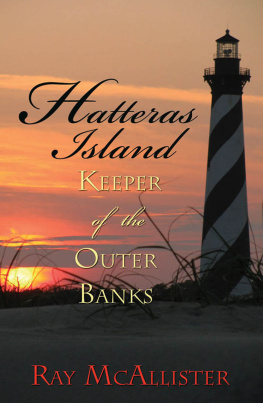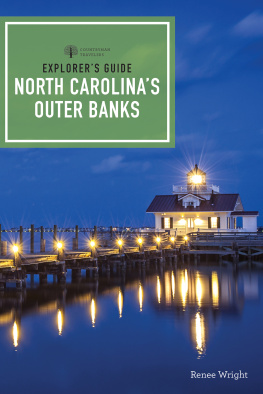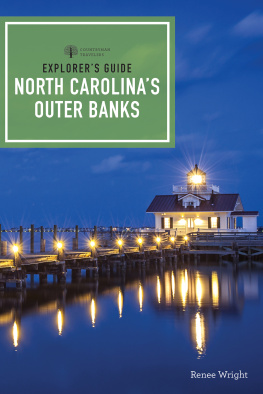
IMAGES
of America
OUTER BANKS SHIPWRECKS
GRAVEYARD OF THE ATLANTIC
ON THE COVER: It was 5:30 in the morning when Helen H. Benedict stranded on the beach in Nags Head. Lifesavers from the Nags Head Life-Saving Station arrived at the scene by 6:45 a.m. It took five hours and 20 trips in the breeches buoy to land all crew and baggage. (Courtesy of Outer Banks History Center.)
IMAGES
of America
OUTER BANKS SHIPWRECKS
GRAVEYARD OF THE ATLANTIC
Mary Ellen Riddle

Copyright 2017 by Mary Ellen Riddle
ISBN 978-1-4671-2410-2
Ebook ISBN 9781439659885
Published by Arcadia Publishing
Charleston, South Carolina
Library of Congress Control Number: 2016937469
For all general information, please contact Arcadia Publishing:
Telephone 843-853-2070
Fax 843-853-0044
E-mail
For customer service and orders:
Toll-Free 1-888-313-2665
Visit us on the Internet at www.arcadiapublishing.com
To the lifesavers who risked their lives to save shipwrecked souls, and to those islanders and caring folk who provided comfort, honor, and sustenance.
CONTENTS
ACKNOWLEDGMENTS
Great appreciation goes to Joseph K. Schwarzer, executive director of the North Carolina Maritime Museum System, for his support and expert guidance. Special thanks go to Marc Corbett for his knowledge, underwater photographs, dogged vigilance, and constant inspiration. Thanks go to Nathan Richards for his knowledge, expertise, and finesse. Thanks also go to the Graveyard of the Atlantic staff, Clara Scarborough and Bill Francis, for help identifying, locating, and photographing artifacts and to Paul Fontenoy for technical information. A thank-you is extended to all those who donated or located photographs, including Dave Alberg, Lynn Anderson, Daniel Berra, Mike Boring, John Bright, Jim Bunch, Mike Carraway, Tama Creef, Kara Fox, Hal Good, Jami P. Lanier, Philatelie Marine, Stuart Parks, Lori Sanderlin, Will Sassarossi, Dave Sommers, Suzanne Tate, Eve Turek, and Ben Wunderly. Thank you, Allyson Ropp, for piratical information. Appreciation goes to collections personnel across the globe who searched for photographs. Thanks go to researchers before me, such as Gary Gentile, David Stick, and Kevin Duffus, for creating a shipwreck history foundation. Special thanks are extended to Arcadia Publishing and my title manager Liz Gurley, who made a detailed project fun. Finally, appreciation goes to my family, Christopher and Zoe, the Riddle clan, and my dear friends who supported the project through their interest and patience.
INTRODUCTION
Imagine a skeletal vessel lying on the ocean floor. Schools of fish dart about providing contrast to the ships lifeless form. These remains provide a door into discovery. A comprehensive and methodical examination of shipwrecks can tell us about the vessels era, people, and places. It can reveal information on piracy, war, and weather and lend insight into a broader cultural landscape of maritime heritagethe history that links the shipwreck to its time. We discover what it was like to live at the edge of a continent, how maritime technology developed, and how people responded to, subsisted on, and, at times, even flourished from shipwrecks.
In the waters off the Outer Banks of North Carolina, from Currituck to Bogue Banks, thousands of shipwrecks rest in the area known as the Graveyard of the Atlantic. Here, epic storms raged around heroic lifesaving events. Warships and merchant ships were ravaged by war. Navigational error caused wrecks and strandings. Whether victims of nature, human error or conflict, or unsolved mystery, shipwrecks provide a perspective on our shared cultural past.
In 1585, the galleass Tiger, a participant in Sir Walter Raleighs Roanoke Voyages, grounded on a shoal in Ocracoke Inlet. Chronicling the event, English explorer Ralph Lane describes a natural threat that long has characterized coastal North Carolina in y Entry whereof all our Fleet struck agrounde, a y Tyger lyinge beatnge vupon y shoalle for y space of ij houres by the dyalle, wee were all in extreme hasarde of being castawaye, but in y ende by the mere worck of god flottynge of wee ranne her agrounde harde to shoare, and soo with grete spoyelle of our prouysyones, saued our selfes and ye Noble shippe also, with her backe whole, which all they marryners aborde thought coolde not possybelly but hau beene broken in sunder.
Valuable provisions were lost that affected the course of the voyage. For more than four centuries, thousands of ships have met similar or worse fateshence the regions long-standing, foreboding title. Even today, with all our technological advances, ships and lives are lost off the Outer Banks. Shoals and weather are ever changing; nature continues to play a major role.
North Carolinas barrier islands lie off the mainland and jut into the Atlantic Ocean. These migrating masses and surrounding waters are subject to a variety of conditions. Winds blowing from the northeast or the southwest generate longshore currents that carry sand and deposit it at the capes to create shoals. These shallow-water sandbars extending 30 to 50 meters or more into the Atlantic are difficult to see and chart and are dangerous to navigate. Equally, the region is known for dynamic weather, with storms forming offshore that produce destructive winds and waves. These conditions, combined with the proximity of the Gulf Stream and extension of the Labrador Currentused by mariners as shipping lanes for centuries to avoid doldrums or to gain speed in their journeycreate ideal circumstances for abundant shipwrecks. Just like Tiger, ships following these currents could find themselves stranded on a shoal or sinking into a raging sea. Vessels perched on shoals bend in ways unnatural to their designs. Wind and waves pounded them, shredding sails, swallowing cargo, splintering ships, and tossing souls into the sea.
Man was as destructive as nature. Pirates targeted the busy shipping routes that passed the North Carolina coast and found secluded hideouts on the nearby islands surrounded by shallow waters. The ever-shifting geography of the coast and inlet required local pilots in light draft vessels to escort larger ships across shoal-infested waters. In fact, piloting was one of the first official jobs available along the coast. Concurrently, these very waterways were perfect for the small, fast piratical sloops, which did not draw as much water as the larger ships their crews plundered and, at times, wrecked.
The Revolutionary War, the War of 1812, the Civil War, and both world wars left their mark on the barrier islands and surrounding waters. Legend has it that bankers lured a British manof-war ashore and attacked and scuttled it. Mystery surrounds the loss of Patriot during the War of 1812. Was its demise an act of war, piracy, or from natural causes? With Hatteras the site of the first amphibious assault in the Civil War, it was not unusual for ship strandings or wrecks to thwart military efforts or even aid them. A vessel could purposely be sunk to act as a blockade or set on fire to stop it from being used.
During World Wars I and II, U-boats attacked Allied ships off the Outer Banks. Approximately 90 Allied vessels and four U-boats were sunk. Although largely unknown to the rest of the country, the war was experienced firsthand by Outer Banks residents. They put forth valiant lifesaving efforts and witnessed fiery explosions of ships at sea that caused their houses to shake and covered beaches with oil and shipwreck debris. Locals observed blackouts, and their once peaceful islands were transformed into a war zone dubbed Torpedo Junction.
Next page







